The AI-powered gait & mobility analytics market is valued at USD 950.0 million in 2025 and is set to reach USD 2,950 million by 2035, recording an absolute increase of USD 2.0 billion over the forecast period. This translates into a total growth of 210.5%, with the market forecast to expand at a compound annual growth rate (CAGR) of 12.0% between 2025 and 2035. The overall market size is expected to grow by approximately 3.1X during the same period, supported by increasing demand for digital rehabilitation solutions, growing artificial intelligence adoption in healthcare, and rising applications across neuro rehab, orthopedics, elder care, and hospital research segments.
The global AI-powered gait & mobility analytics market represents a critical segment within the digital healthcare and rehabilitation technology industry, driven by the superior analytical capabilities of AI-based mobility products and the diverse functional properties of various gait analysis types. These specialized analytics products are produced through precision development processes, providing consistent clinical standards and standardized performance characteristics for various medical, rehabilitation, and research applications including movement assessment, therapy monitoring, and specialized diagnostic operations. The processing mechanism enables controlled AI integration development, making these products particularly suitable for healthcare professionals and applications requiring specific mobility analysis characteristics.
The market encompasses various platform types, deployment grades, and specialized development methods tailored for specific healthcare requirements. Modern AI-powered gait & mobility analytics production incorporates advanced artificial intelligence, sensor fusion optimization, and enhanced processing techniques that can deliver consistent quality across variable analytics formulations while maintaining diagnostic integrity over extended usage periods. The integration of quality control systems, clinical compliance protocols, and standardized processing parameters has further enhanced the value proposition of these analytics materials among healthcare manufacturers seeking reliable diagnostic performance and consistent clinical outcomes.
Market dynamics are significantly influenced by rising mobility disorder awareness, particularly in developed markets where healthcare digitization and precision rehabilitation drive demand for AI-powered gait & mobility analytics materials. The healthcare sector's increasing emphasis on intelligent diagnostics, advanced rehabilitation formulations, and specialized mobility medicine applications has created substantial demand for high-quality AI-powered gait & mobility analytics solutions in hospital applications, rehabilitation clinic operations, and research facility manufacturing. Additionally, the growing trend toward personalized healthcare and advanced rehabilitation technologies has amplified the need for versatile analytics materials capable of supporting diverse healthcare requirements and mobility medicine applications.
Consumer purchasing patterns show a marked preference for certified AI-powered gait & mobility analytics varieties that combine advanced development methods with consistent diagnostic characteristics, multiple application options, and comprehensive healthcare profiles for diverse clinical applications. The market has witnessed significant technological advancement in development efficiency design, quality control systems, and clinical compliance solutions, making these products more suitable for demanding healthcare environments, extended diagnostic requirements, and precision-critical rehabilitation operations.
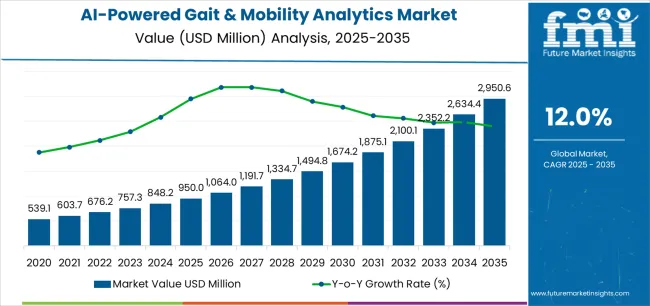
AI-Powered Gait & Mobility Analytics Market Key Takeaways
| Metric | Value |
|---|---|
| Estimated Value in (2025E) | USD 950.0 million |
| Forecast Value in (2035F) | USD 2,950 million |
| Forecast CAGR (2025 to 2035) | 12.0% |
Between 2025 and 2030, the AI-powered gait & mobility analytics market is projected to expand from USD 950.0 million to USD 1.67 billion, resulting in a value increase of USD 720.0 million, which represents 36.0% of the total forecast growth for the decade. This phase of development will be shaped by increasing AI healthcare adoption, rising demand for alternative rehabilitation solutions, and growing availability of premium AI-powered gait & mobility analytics varieties across healthcare and technology channels.
Between 2030 and 2035, the market is forecast to grow from USD 1.67 billion to USD 2,950 million, adding another USD 1.28 billion, which constitutes 64.0% of the overall ten-year expansion. This period is expected to be characterized by the advancement of specialty AI-powered gait & mobility analytics applications, the development of enhanced analytics materials for healthcare improvement, and the expansion of certified AI-powered gait & mobility analytics availability across diverse clinical and rehabilitation segments. The growing emphasis on intelligent diagnostics and advanced healthcare processing will drive demand for premium AI-powered gait & mobility analytics varieties with enhanced functional properties, improved diagnostic characteristics, and superior performance profiles in specialized clinical applications.
Between 2020 and 2024, the AI-powered gait & mobility analytics market experienced steady growth, driven by increasing awareness of rehabilitation technology benefits and growing recognition of AI-powered gait & mobility analytics' effectiveness in healthcare applications following extensive digital health campaigns. The market developed as manufacturers recognized the advantages of AI-powered gait & mobility analytics over traditional rehabilitation alternatives in diagnostic-sensitive applications and began seeking specialized products designed for specific mobility analysis and healthcare requirements. Technological advancement in AI technology and clinical compliance began emphasizing the critical importance of maintaining healthcare integrity while enhancing functional performance and improving diagnostics across diverse AI-powered gait & mobility analytics applications.
From 2030 to 2035, the market is forecast to grow from USD 1.67 billion to USD 2,950 million, adding another USD 1.28 billion, which constitutes 64.0% of the overall ten-year expansion. This period is expected to be characterized by the advancement of specialized processing techniques in analytics production systems, the integration of quality enhancement protocols for optimal diagnostic retention, and the development of customized analytics formulations for high-performance healthcare applications. The growing emphasis on material functionality and product reliability will drive demand for premium varieties with enhanced processing capabilities, improved storage stability, and superior healthcare performance characteristics.
Between 2020 and 2024, the AI-powered gait & mobility analytics market experienced robust growth, driven by increasing awareness of alternative healthcare benefits and growing recognition of specialized analytics systems' effectiveness in supporting diverse clinical operations across rehabilitation facilities and specialty healthcare environments. The market developed as users recognized the potential for AI-powered gait & mobility analytics products to deliver functional advantages while meeting modern requirements for intelligent diagnostics and reliable healthcare performance. Technological advancement in processing optimization and quality enhancement began emphasizing the critical importance of maintaining material consistency while extending product durability and improving user satisfaction across diverse AI-powered gait & mobility analytics applications.
Market expansion is being supported by the increasing global emphasis on digital rehabilitation solutions and the corresponding shift toward alternative analytics systems that can provide superior diagnostic characteristics while meeting healthcare requirements for advanced AI solutions and cost-effective precision options. Modern healthcare manufacturers are increasingly focused on incorporating analytics materials that can enhance clinical performance while satisfying demands for consistent, precisely controlled AI integration and optimized healthcare profiles. AI-powered gait & mobility analytics' proven ability to deliver healthcare excellence, functional versatility, and diverse application possibilities makes them essential materials for healthcare-focused professionals and quality-focused rehabilitation technology manufacturers.
The growing emphasis on intelligent diagnostics and advanced healthcare processing is driving demand for high-performance AI-powered gait & mobility analytics systems that can support distinctive clinical outcomes and comprehensive diagnostic benefits across rehabilitation applications, orthopedic treatment, and specialty research facility manufacturing. Healthcare preference for analytics solutions that combine functional excellence with advanced processing methods is creating opportunities for innovative implementations in both traditional and emerging clinical applications. The rising influence of digital health transformation and alternative diagnostic approaches is also contributing to increased adoption of AI-powered gait & mobility analytics solutions that can provide authentic functional benefits and reliable diagnostic characteristics.
The market is segmented by platform, end user, deployment model, and customer type. By platform, the market is divided into wearable IMU/insole sensors, vision/camera AI, instrumented walkway/force plate, and robotic rehab analytics. Based on end user, the market is categorized into neuro rehab & PT clinics, orthopedics & sports medicine, elder/fall-risk management, and hospital gait labs/research. By deployment model, the market includes on-prem clinical systems, remote/home monitoring, hybrid (clinic + remote), and cloud analytics for device OEMs. By customer type, the market encompasses hospitals/health systems, rehab chains, sports/performance centers, and senior care/assisted living networks.
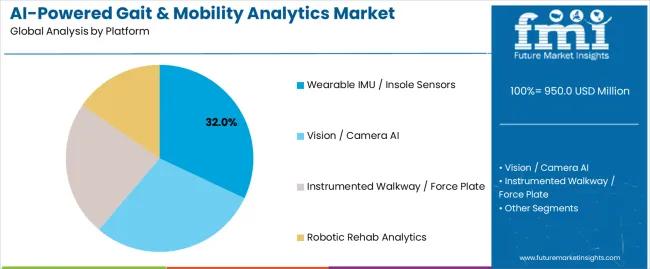
The wearable IMU/insole sensors segment is projected to account for 32.0% of the AI-powered gait & mobility analytics market in 2025, reaffirming its position as the leading platform category. Healthcare manufacturers and rehabilitation professionals increasingly utilize wearable IMU/insole sensor technologies for their superior mobility tracking characteristics, established diagnostic properties, and essential functionality in diverse healthcare applications across multiple clinical sectors. Wearable IMU/insole sensor's proven performance characteristics and established cost-effectiveness directly address user requirements for reliable diagnostic control and optimal processing precision in rehabilitation and specialty orthopedic applications.
This platform segment forms the foundation of modern digital rehabilitation patterns, as it represents the analytics type with the greatest healthcare versatility and established compatibility across multiple clinical systems. Healthcare industry investments in alternative AI technology and rehabilitation optimization continue to strengthen adoption among precision-focused manufacturers. With processors prioritizing technology reliability and functional consistency, wearable IMU/insole sensor systems align with both performance objectives and healthcare requirements, making them the central component of comprehensive digital rehabilitation strategies.
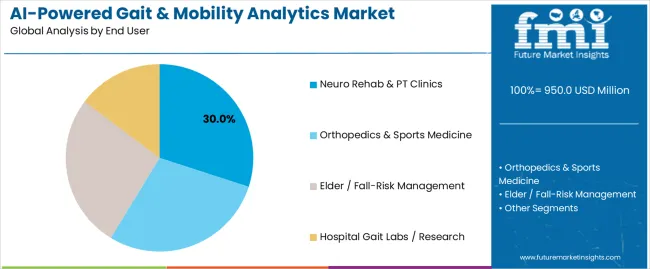
Neuro rehab & PT clinics is projected to represent 30.0% of the AI-powered gait & mobility analytics market in 2025, underscoring its important role as a key end user for performance-focused users seeking superior rehabilitation outcomes and enhanced clinical credentials. Rehabilitation facilities and clinical operations prefer neuro rehab & PT clinic applications for their established performance characteristics, proven therapeutic development, and ability to maintain exceptional clinical precision while supporting versatile application coverage during diverse rehabilitation activities. Positioned as essential end users for quality-focused healthcare processors, neuro rehab & PT clinic offerings provide both functional excellence and clinical optimization advantages.
The segment is supported by continuous improvement in rehabilitation technology and the widespread availability of established performance standards that enable quality assurance and premium positioning at the clinical level. Additionally, rehabilitation facilities are optimizing technology selections to support application-specific requirements and comprehensive clinical strategies. As rehabilitation technology continues to advance and facilities seek consistent technology performance, neuro rehab & PT clinic applications will continue to drive market growth while supporting operational efficiency and quality optimization strategies.
The AI-powered gait & mobility analytics market is advancing rapidly due to increasing digital healthcare adoption and growing need for alternative analytics solutions that emphasize superior diagnostic performance across healthcare segments and specialty rehabilitation applications. However, the market faces challenges, including competition from other alternative healthcare technology types, price volatility in raw AI component materials, and processing complexity considerations affecting development costs. Innovation in AI technology enhancement and specialized analytics formulations continues to influence market development and expansion patterns.
Expansion of Remote and Personalized Healthcare Applications
The growing adoption of AI-powered gait & mobility analytics with remote certification and personalized positioning is enabling healthcare companies to develop clinical products that provide distinctive diagnostic benefits while commanding premium pricing and enhanced healthcare appeal characteristics. Remote applications provide superior market positioning while allowing more sophisticated product differentiation features across various healthcare categories. Healthcare companies are increasingly recognizing the market advantages of personalized analytics positioning for comprehensive clinical outcomes and premium-focused healthcare marketing.
Integration of AI and Performance Enhancement Systems
Modern AI-powered gait & mobility analytics manufacturers are incorporating advanced AI enhancement, performance improvement capabilities, and diagnostic supplementation systems to enhance product functionality, improve healthcare effectiveness, and meet consumer demands for enhanced clinical solutions. These systems improve product performance while enabling new applications, including specialty healthcare programs and specialized rehabilitation protocols. Advanced performance integration also allows manufacturers to support premium product positioning and healthcare assurance beyond traditional analytics performance requirements.
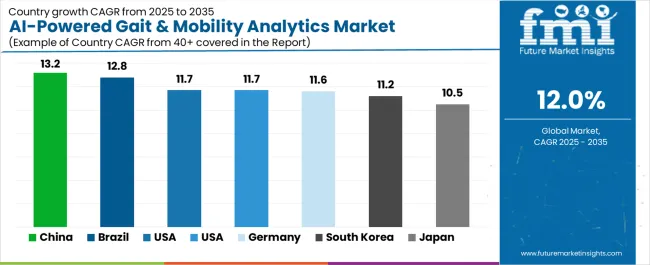
| Countries | CAGR (2025 to 2035) |
|---|---|
| China | 13.2% |
| Brazil | 12.8% |
| USA | 11.7% |
| UK | 11.7% |
| Germany | 11.6% |
| South Korea | 11.2% |
| Japan | 10.5% |
The AI-powered gait & mobility analytics market is experiencing robust growth globally, with China leading at a 13.2% CAGR through 2035, driven by the expanding digital healthcare sector, growing AI technology adoption, and increasing adoption of analytics materials. Brazil follows at 12.8%, supported by rising rehabilitation technology capabilities, expanding healthcare industry, and growing acceptance of AI-powered materials. USA shows growth at 11.7%, emphasizing established healthcare standards and comprehensive AI analytics development. UK records 11.7%, focusing on healthcare industry modernization and rehabilitation market growth. Germany demonstrates 11.6% growth, prioritizing advanced healthcare technologies and AI-focused clinical products.
The report covers an in-depth analysis of 40+ countries, top-performing countries are highlighted below.
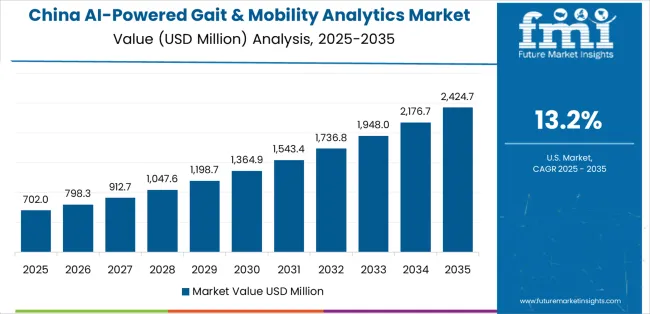
Revenue from AI-powered gait & mobility analytics consumption and sales in China is projected to exhibit exceptional growth with a CAGR of 13.2% through 2035, driven by the country's rapidly expanding digital healthcare sector, favorable medical policies toward AI technologies, and initiatives promoting analytics development across major healthcare regions. China's position as a global healthcare technology leader and increasing focus on processed AI materials are creating substantial demand for high-quality AI-powered gait & mobility analytics in both domestic and international markets. Major healthcare companies and technology distributors are establishing comprehensive analytics production capabilities to serve growing demand and emerging clinical opportunities.
Revenue from AI-powered gait & mobility analytics products in Brazil is expanding at a CAGR of 12.8%, supported by rising domestic healthcare consumption, growing AI technology adoption, and expanding technology distributor capabilities. The country's developing healthcare infrastructure and increasing investment in AI technologies are driving demand for AI-powered gait & mobility analytics across both traditional and modern healthcare applications. International technology companies and domestic processors are establishing comprehensive operational networks to address growing market demand for alternative analytics products and efficient AI processing solutions.
Revenue from AI-powered gait & mobility analytics products in USA is projected to grow at a CAGR of 11.7% through 2035, supported by the country's mature healthcare processing standards, established AI technology regulations, and leadership in specialty analytics technology. USA's sophisticated healthcare standards and strong support for alternative technology systems are creating steady demand for both traditional and innovative analytics varieties. Leading technology manufacturers and specialty distributors are establishing comprehensive operational strategies to serve both domestic markets and growing export opportunities.
Revenue from AI-powered gait & mobility analytics products in the UK is projected to grow at a CAGR of 11.7% through 2035, driven by the country's emphasis on healthcare industry development, technology processing growth, and growing distributor capabilities. British manufacturers and processing facilities consistently seek quality-focused technologies that enhance product performance and support processing excellence for both traditional and modern healthcare applications. The country's position as a European healthcare leader continues to drive innovation in specialized analytics applications and healthcare processing standards.
Revenue from AI-powered gait & mobility analytics products in Germany is projected to grow at a CAGR of 11.6% through 2035, supported by established healthcare standards, mature rehabilitation markets, and emphasis on AI alternatives across healthcare and technology sectors. German manufacturers and specialty processors prioritize quality technologies and consistent performance, creating steady demand for premium analytics solutions. The country's comprehensive market innovation and established healthcare practices support continued development in specialized applications.
Revenue from AI-powered gait & mobility analytics products in South Korea is projected to grow at a CAGR of 11.2% through 2035, supported by established healthcare standards, mature rehabilitation markets, and emphasis on AI alternatives across healthcare and technology sectors. Korean manufacturers and specialty processors prioritize quality technologies and consistent performance, creating steady demand for premium analytics solutions. The country's comprehensive market maturity and established healthcare practices support continued development in specialized applications.
Revenue from AI-powered gait & mobility analytics products in Japan is projected to grow at a CAGR of 10.5% through 2035, supported by the country's emphasis on technology quality, healthcare excellence, and advanced processing technology integration requiring efficient technology solutions. Japanese healthcare facilities and quality-focused operations prioritize technical performance and rehabilitation precision, making specialized analytics essential materials for both traditional and modern healthcare applications. The country's comprehensive healthcare leadership and advancing quality patterns support continued market expansion.
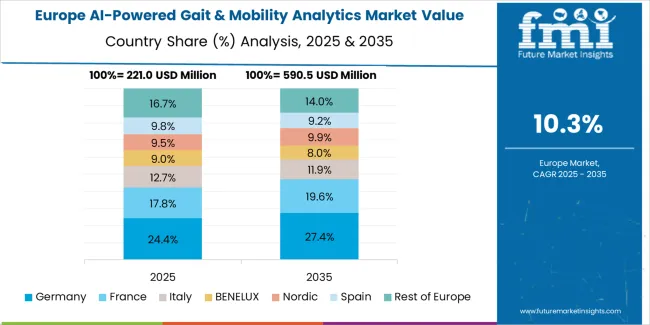
The Europe AI-powered gait & mobility analytics market is projected to grow from USD 285.0 million in 2025 to USD 885.0 million by 2035, registering a CAGR of 12.0% over the forecast period. Germany is expected to maintain its leadership position with a 28.0% market share in 2025, declining slightly to 27.5% by 2035, supported by its advanced healthcare infrastructure and major rehabilitation technology hubs including Berlin and Munich.
France follows with a 22.0% share in 2025, projected to reach 22.5% by 2035, driven by comprehensive healthcare modernization programs and AI technology initiatives. The United Kingdom holds a 20.0% share in 2025, expected to decrease to 19.5% by 2035 due to market maturation. Italy commands a 15.0% share, while Spain accounts for 10.0% in 2025. The Rest of Europe region is anticipated to gain momentum, expanding its collective share from 5.0% to 5.5% by 2035, attributed to increasing analytics adoption in Nordic countries and emerging Eastern European markets implementing healthcare technology programs.
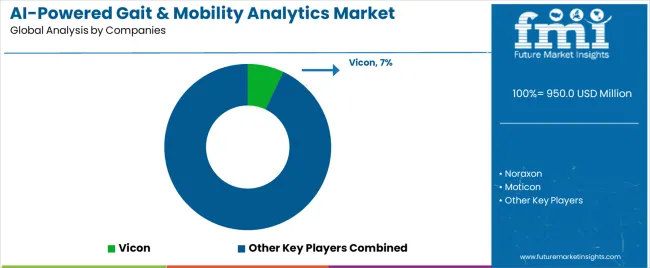
The AI-powered gait & mobility analytics market is characterized by competition among established healthcare technology manufacturers, specialized analytics companies, and integrated rehabilitation solution providers. Companies are investing in advanced AI technologies, specialized processing engineering, product innovation capabilities, and comprehensive distribution networks to deliver consistent, high-quality, and reliable AI-powered gait & mobility analytics products. Innovation in AI processing efficiency optimization, quality control advancement, and healthcare-focused product development is central to strengthening market position and customer satisfaction.
Vicon leads the market with 7.0% share with a strong focus on AI technology innovation and comprehensive healthcare solutions, offering clinical and specialty systems with emphasis on quality excellence and diagnostic heritage. Noraxon provides integrated advanced analytics solutions with a focus on healthcare market applications and functional technology networks. Moticon delivers comprehensive gait analytics products with a focus on healthcare positioning and rehabilitation quality. BTS Bioengineering specializes in AI-based analytics systems with an emphasis on clinical applications. GaitUp (MindMaze) focuses on comprehensive analytics processing with advanced AI technology and healthcare positioning capabilities.
| Items | Values |
|---|---|
| Quantitative Units (2025) | USD 950.0 million |
| Platform | Wearable IMU/Insole Sensors, Vision/Camera AI, Instrumented Walkway/Force Plate, Robotic Rehab Analytics |
| End User | Neuro Rehab & PT Clinics, Orthopedics & Sports Medicine, Elder/Fall-Risk Management, Hospital Gait Labs/Research |
| Deployment Model | On-Prem Clinical Systems, Remote/Home Monitoring, Hybrid (Clinic + Remote), Cloud Analytics for Device OEMs |
| Customer Type | Hospitals/Health Systems, Rehab Chains, Sports/Performance Centers, Senior Care/Assisted Living Networks |
| Regions Covered | North America, Europe, Asia-Pacific, Latin America, Middle East & Africa |
| Countries Covered | USA, UK, Germany, France, Japan, South Korea, China, Brazil, and 40+ countries |
| Key Companies Profiled | Vicon, Noraxon, Moticon, BTS Bioengineering, GaitUp, and other leading AI-powered gait & mobility analytics companies |
| Additional Attributes | Dollar sales by platform, end user, deployment model, customer type, and region; regional demand trends, competitive landscape, technological advancements in analytics processing, quality optimization initiatives, healthcare enhancement programs, and premium product development strategies |
The global AI-powered gait & mobility analytics market is estimated to be valued at USD 950.0 million in 2025.
The market size for the AI-powered gait & mobility analytics market is projected to reach USD 2,950.6 million by 2035.
The AI-powered gait & mobility analytics market is expected to grow at a 12.0% CAGR between 2025 and 2035.
The key product types in AI-powered gait & mobility analytics market are wearable imu / insole sensors, vision / camera ai, instrumented walkway / force plate and robotic rehab analytics.
In terms of end user, neuro rehab & pt clinics segment to command 30.0% share in the AI-powered gait & mobility analytics market in 2025.






Full Research Suite comprises of:
Market outlook & trends analysis
Interviews & case studies
Strategic recommendations
Vendor profiles & capabilities analysis
5-year forecasts
8 regions and 60+ country-level data splits
Market segment data splits
12 months of continuous data updates
DELIVERED AS:
PDF EXCEL ONLINE
AI-powered Spinal Surgery Market Size and Share Forecast Outlook 2025 to 2035
AI-Powered Sleep Technologies Market Size and Share Forecast Outlook 2025 to 2035
AI-Powered Behavioral Therapy Market Size and Share Forecast Outlook 2025 to 2035
AI-powered In-car Assistant Market Forecast and Outlook 2025 to 2035
AI-Powered CRM Platform Market Forecast Outlook 2025 to 2035
AI-powered Care Coordination Market Analysis - Size, Share, and Forecast Outlook 2025 to 2035
AI-Powered Stethoscope Market Size and Share Forecast Outlook 2025 to 2035
AI-Powered Storage Market Growth - Trends & Forecast 2025 to 2035
AI-powered Design Tools Market Insights - Growth & Forecast 2025 to 2035
Gait Trainer Market Growth - Trends, Demand & Forecast 2025 to 2035
Marine Toxin Market Size and Share Forecast and Outlook 2025 to 2035
Cryoglobulinemic Vasculitis Therapeutics Market Size and Share Forecast Outlook 2025 to 2035
At-home Ulcer Testing Market Size and Share Forecast Outlook 2025 to 2035
Blood Compatible Nanocoating Market Size and Share Forecast Outlook 2025 to 2035
High-frequency RF Evaluation Board Market Size and Share Forecast Outlook 2025 to 2035
High Viscosity Mixer Market Size and Share Forecast Outlook 2025 to 2035
Long-wear Glucose Sensors Market Size and Share Forecast and Outlook 2025 to 2035
Heavy Duty Pallet Rack Market Size and Share Forecast Outlook 2025 to 2035
Harsh Environments Fiber Optic Market Size and Share Forecast Outlook 2025 to 2035
Hand Towel Automatic Folding Machine Market Size and Share Forecast Outlook 2025 to 2035

Thank you!
You will receive an email from our Business Development Manager. Please be sure to check your SPAM/JUNK folder too.
Chat With
MaRIA